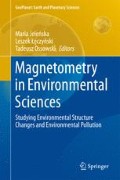Abstract
The article presents the results of an analysis of the surface layer of bottom sediments in the naval harbour in Hel. During field work conducted in June 2013, 54 sediment samples were collected. The aim of the study was to examine magnetic susceptibility of harbour sediment as a parameter determining the degree of anthropopressure. As part of laboratory tests, grain size analysis was performed in order to determine organic matter content and magnetic susceptibility of the sediment. The study also measured the impact of environmental factors on fluctuations in the other studied parameters. The results demonstrate increased dynamics of sedimentary environment in the open part of the naval harbour, better sediment sorting and reduced percentage share of <0.063 mm grain size fraction. Variability in magnetic susceptibility values measured in isolated parts of the harbour correlates with increased percentage share of the fine fraction and LOI%. A significant impact on the accumulation of pollutants in surface sediments is exerted by the harbour’s closed hydrodynamic conditions.
References
Blott SJ, Pye K (2001) GRADISTAT: A grain size distribution and statistics package for the analysis of unconsolidated sediments. Earth Surf Proc Land 26:1237–1248
Ciborowski T (2010) Substancja organiczna. In: Bolałek J. (ed.) Fizyczne, biologiczne i chemiczne badania morskich osadów dennych, Gdańsk: Wydawnictwo Uniwersytetu Gdańskiego, pp 287–290
Gołuchowska B, Strzyszcz Z, Kusza G (2012) Magnetic susceptibility and heavy metal content in dust from the lime plant and the cement plant in Opole Voivodeship. Archives of Environmental Protection 38(2):71–80
Krumbein WC (1964) Some remarks on the phi notation. J. Sedim. Petrol. 34:165–197
Łęczyński L, Szymczak E (2010) Własności fizyczne osadów dennych. In: Bolałek J (ed.) Fizyczne, biologiczne i chemiczne badania morskich osadów dennych. Gdańsk: Wydawnictwo UG, pp 63–115
Magiera T, Lis J, Nawrocki J, Strzyszcz Z (2002) Podatność magnetyczna gleb Polski. Atlas, PIG Warszawa
Myślińska E (2010) Laboratoryjne badania gruntów. Wydawnictwo Uniwersytetu Warszawskiego, Warszawa
Pasecki R (2010) Hel 1939–1945 Baza jednostek szkolnych i eksperymentalnych U-bootwaffe. Muzeum Obrony Wybrzeża. Stowarzyszenie “przyjaciele Helu”. Zeszyt 10, p 64
Piekarek-Jankowska H, Wojcieszek D (2010) Metody pobierania próbek morskich osadów dennych. In: Bolałek J. (ed.) Fizyczne, biologiczne i chemiczne badania osadów dennych. Wydawnictwo Uniwersytetu Gdańskiego, Gdańsk, pp 19–23
Strzyszcz Z, Rachwał M, (2010) Zastosowanie magnetometrii do monitoringu i oceny ekologicznej technogennych pyłów oraz gleb na obszarach objętych wpływem emisji przemysłowych. Prace i Studia, No. 78, IPIŚ PAN, Zabrze 2010, pp 88
Udden JA (1914) The mechanical composition of plastic sediments. Bull. Geol. Soc. Am. 25:655–744
Winters WJ, Dillon WP, Pecher IA, Mason DH (2000) “GHASTLI—determining physical properties of sediment containing natural and laboratory formed gas hydrate” Coastal Systems and Continental Margins—Natural Gas Hydrate in Oceanic and Permafrost Environments. Kluwer Academic Publishers, Dordrecht, Netherlands, pp 311–322
Wentworth CA (1922) Scale of grade and class terms for clastic sediments. J. Geol. 30:377–392
Zawadzki J, Fabijańczyk P, Magiera T, Strzyszcz Z (2010) Study of litter influence on magnetic susceptibility measurements of urban forest topsoils using the MS2D sensor. Environ. Earth Sci. 61(2):223–230
Zawadzki J, Magiera T, Fabijańczyk P, Kusza G (2012) Geostatistical 3-dimensional integration of measurements of soil magnetic susceptibility. Environ. Monit. Assess. 184(5):3267–3278
Author information
Authors and Affiliations
Corresponding author
Editor information
Editors and Affiliations
Rights and permissions
Copyright information
© 2018 Springer International Publishing AG
About this chapter
Cite this chapter
Łęczyński, L., Kłostowska, Ż., Kusza, G., Ossowski, T., Arciszewski, B., Koza, R. (2018). The Impact of Grain Size Composition and Organic Matter Content on Magnetic Susceptibility of Anthropogenically Transformed Bottom Sediments, as Exemplified by the Former Naval Harbour in Hel. In: Jeleńska, M., Łęczyński, L., Ossowski, T. (eds) Magnetometry in Environmental Sciences. GeoPlanet: Earth and Planetary Sciences. Springer, Cham. https://doi.org/10.1007/978-3-319-60213-4_7
Download citation
DOI: https://doi.org/10.1007/978-3-319-60213-4_7
Published:
Publisher Name: Springer, Cham
Print ISBN: 978-3-319-60212-7
Online ISBN: 978-3-319-60213-4
eBook Packages: Earth and Environmental ScienceEarth and Environmental Science (R0)

